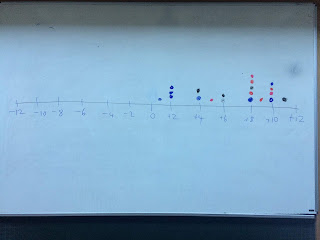 |
| Results from 2020 Jamboard (link) |
 |
| results from Nov 2019 |
 |
| results from BCFE 2019 |
 |
| results from Nov 2010 |
 |
| results from Nov 2011 |
 |
| Creating an 'organic' histogram of the results |
Objective To assess how prepared I am to manage a creative team and a truly innovative project.
These questions are set out as either/or style. There is no middle ground, they are not 'fair'. They act as a forcing function to get you to honestly resort to your true belief on how you intend to manage creative work teams. Your answers are naturally founded on your own personal beliefs and/or experiences. Your answers will probably change if the test is taken at another point in your career.
Instruction stage 1
Ask everyone to self-access the following questions.
| Score | Either | Or | Score |
|---|---|---|---|
| +1 | Seek out and be attentive to people who will evaluate and endorse the work | Seek out ways to avoid, distract, and bore customers, critics, and anyone who just wants to talk about money | -1 |
| +1 | Think of some sound or practical things to do, and plan to do them | Think of some ridiculous or impractical things to do, and plan to do them | -1 |
| +1 | Reward success; punish failure and inaction | Reward failure and success; punish inaction | -1 |
| +1 | Bring happy people together and make sure they get along | Bring happy people together and get them to fight | -1 |
| +1 | Promote “fast learners” (of the organizational code) | Promote “slow learners” (of the organizational code) | -1 |
| +1 | Hire people who make you feel comfortable, whom you like | Hire people who make you uncomfortable, even those you dislike | -1 |
| +1 | Hire people you (probably) do need | Hire people you (probably) don’t need | -1 |
| +1 | Take your past experiences and replicate them | Take your past experiences and forget them | -1 |
| +1 | Use job interviews to screen candidates and, especially, to recruit new employees | Use job interviews to get new ideas, not to screen candidates | -1 |
| +1 | Do something that will probably succeed, then convince yourself and everyone else that success is certain | Do something that will probably fail, then convince yourself and everyone else that success is certain | -1 |
| +1 | Ignore people who have never solved the exact problem you face | Ignore people who have solved the exact problem you face | -1 |
| +1 | Encourage people to pay attention to and obey their bosses and peers | Encourage people to ignore and defy their bosses and peers | -1 |
Instruction stage 2
Provide Sutton's principles paraphrased below for creative teams and then open the discussion, e.g. consider some of the questions below.
- Place bets on ideas without heeding projected ROI.
- Radical innovation implies ignoring what worked before.
- Take happy people and goad them into disagreement.
- Reward action, success AND failure.
- Have people who don’t fit in.
- Disagreements are necessary.
- Use new employees to bring in NEW ideas.
- Generate and use NEW ideas.
Discussion
- Are the recommendations irresponsible?
- Is a creative culture doomed to self-destruction?
- Can a creative development culture coexist with general production?
- Are Sutton's principles simply those that apply in startups?
- If this is startup thinking or behaviour where does it fit in 'scale organisations'?
- Must innovation efforts be separated from the mainstream organisation?
- Does the "Innovator's Dilemma" imply that innovation efforts need independence to succeed?
- Thinking of the possibility of 'Zones' of creative production occurring within the traditional monolithic organisation; Characterise a creative zone or project in such a way that it can be understood, appreciated and supported by a wider conventional organisation: skunk works, black team, blue sky, laboratory...
Observation: This test reveals how 'prepared' for and 'aware of' we are, of the intrinsic demands of creative innovative design environments. In spite of rhetoric to the contrary most organisations and most employees are not involved in innovation. In the main we repeat and reproduce routines that extract value from existing products, markets, customers, business models. Consequently most of us adhere to ingrained approaches to valuing, managing and acting within teams and their wider organisations.
Consider Ken Schwaber's commentary on the relationship between Agile and the PMI...
"We have found that the role of the project manager is counterproductive in complex, creative work. The project manager’s thinking, as represented by the project plan, constrains the creativity and intelligence of everyone else on the project to that of the plan, rather than engaging everyone’s intelligence to best solve the problems." (link)
References
Cliff Kuang. The 'done' manifesto: 13 Rules For Realizing Your Creative Vision. 2011 (link)
Nilofer Merchant's post the "Eight Dangers of Collaboration" (link)
SUTTON, R. I. 2001. The Weird Rules of Creativity. Harvard Business Review, 79, 10.
SUTTON, R. I. 2001. Weird Ideas That Work: 11 1/2 Practices for Promoting, Managing, and Sustaining Innovation, Free Press.
 |
| results from FTa 2015 |
 |
| results from FTb 2015 |
 |
| results from PT 2015 |
 |
| results from PT class 2013 |
 |
| results from FT class 2013 |
 |
| results from class 2012 |